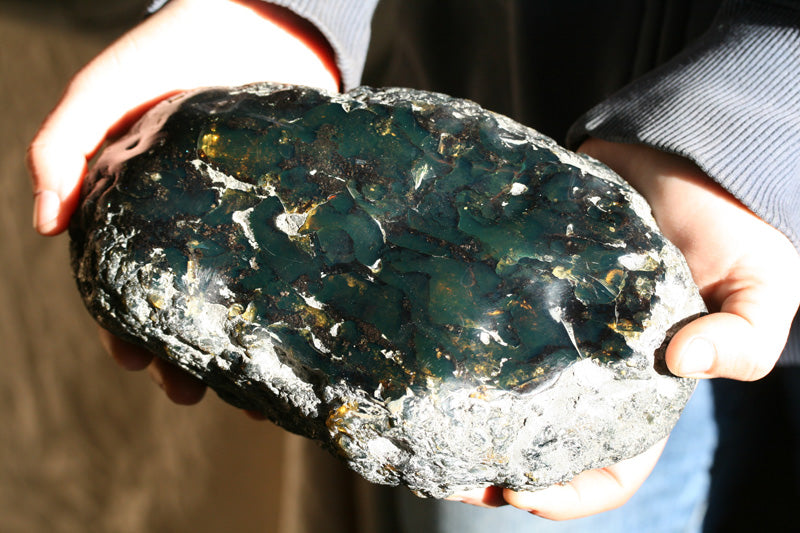Amber: Gem of the Sun
What is amber?
Amber is the fossilized tree resin (not sap) of now-extinct coniferous trees which grew millions of years ago. Sap is primarily composed of water and sugars within the heartwood which nourish the tree. Resin is a fragrant substance composed of acids and terpenes which flows just under the bark and is released to protect and seal wounds when branches are broken or pests bore into or damage bark. Over millions of years, as the volatile oils within the resin have been released, it has hardened into the solid substance we know as amber. Unlike traditional mineralized fossils, amber still remains an organic substance, rather than being inorganic like a stone. For this reason, amber is classified as an 'organic gem,' along with pearls, coral, ivory and jet.

Where does amber come from?
Amber is the fossil resin of a few species of extinct coniferous and leguminous trees which grew in large forests around the world approximately 20 to 40 million years ago. The largest deposit of amber on Earth lies along the Baltic Sea, and it also occurs in the Dominican Republic, Mexico, and of lesser quantity and quality in Canada, the United States, Africa, Myanmar (Burma), and Indonesia. It occurs in near-surface coastal deposits and at various depths close to the surface of the earth, and is sometimes mined by digging pits or small tunnels into deposit areas. It is not uncommon, particularly in the Western hemisphere, for amber deposits to be located in mountainous regions, sometimes many kilometers from its geological origin due to movement in the Earth's crust and the geological upheavals which create mountains and valleys.

The highlands of Chiapas, where the below amber extraction mine (hand dug) is located.

Amber Colors
All amber falls within the color spectrum of yellow-orange-red with pale yellow to yellow orange being the most common, orange tinged or cognac amber being more valuable and rarer, and true cherry red amber being the most rare and thus most highly valued. There is also a buttery white to pale yellow opaque amber that occurs in the Baltic region, and there are 'black' ambers caused by heavy inclusion of organic materials. There are no solid colored ambers outside of this color range that occur naturally. Cherry red material is the result of formation near the surface of the Earth, with iron salts leeching into the outer crust of the amber forming a thin (1-4mm on average) layer of true red material. Rarely does this coloration continue through the piece unless it is very small. We can cut cabochons from this material but solid red amber plugs are not physically possible.

Some ambers exhibit a light effect known as a 'sheen,' and this is usually a shade of green, rarely blue. Chiapas and Dominican ambers in particular will show this effect, and it is the result of carbon and other atoms within the material fluorescing upon irradiation from ultraviolet rays in sunlight. Amber will also fluoresce when exposed to backlight and this color is usually a white to bluish glow. Interestingly, only the internal non-red portion of red amber will fluoresce in this manner. The red portions are not reactive. There are no ambers which have a true green or blue coloration found anywhere in the world.


Inclusions in Amber
Organic inclusions generally manifest as black or black with a reddish tinge and can be so densely distributed within the material that it appears solid black in color with no translucency. Inclusions are generally ancient soil and small bits of plant matter from the forest floor. The more included the amber, the more fractured and unpredictable it will be during carving. We can create plugs and basic shapes from included amber but will generally shy away from carving details into heavily included ambers because of the odds of the material fracturing (higher inclusion density means less amber).



Rarely, one finds inclusions of insects or discernible plant parts such as intact leaves. Organic inclusions such as insects or botanicals, especially in clear amber, increase the value of the material exponentially. We can work these materials upon special request and there is a premium associated with the sourcing and working of amber plugs or cabochons which display botanical or insect inclusions.


Above, insect trapped in Chiapas amber, below a set of plugs from a very rare piece of amber with Hymenaea leaf frozen in time.

Chiapas Amber Body Jewelry
Onetribe primarily uses a variety of amber collected near San Cristobal las Casas in the state of Chiapas, Mexico. We prefer this variety because of the cultural associations it has with our Native North, Central and South American cultures. Aztec rulers demanded large pieces of raw amber and amber jewelry such as large amber labret pieces as tributes from the amber yielding areas under their control. Beautiful amber ear flares from Mesoamerican cultures can be found in the anthropology museums in Mexico City and Oaxaca, Mexico.
We also prefer this material because of the superior coloration and workability versus amber from other regions. Chiapas amber, in our experience, tends to be a clearer, less cloudy amber with more color density (denser/deeper color than an equal thickness of Baltic material, for example) and tends to be less brittle, allowing it to hold more carved detail. Amber from this region varies in color from very pale yellow to darker golden yellows, yellow-oranges, cognac and red. It occurs in the form of nodules from bean to football sized, often encrusted in sediment.


Check out our amber plugs and our HONEY ear weights with honeycomb inlays, both carved from Chiapas amber.
Historical Use in Jewelry
Amber has been used for thousands of years as a precious gem in cultures all over the world. It was so highly valued that just as Maya kings were buried with priceless jade artifacts, European stone-age man buried those with societal influence and power with hoards of amber for their use in the afterlife. The earliest amber artifacts from Europe are small natural lumps drilled with holes to be worn in the form of pendants, and date to as old as 12,000 B.C. Fierce nomadic warrior tribes from the Mesolithic period wore pendants carved in the shape of axe heads to protect them from harm.
Amber was an important commodity and adornment in Greek and Roman societies, and it was written about extensively by intellectuals of the day. The color of common amber, reminiscent of sunlight, was of particular significance, as was the ability of amber to generate static electricity, which added to its mystique. In these cultures, amber was used as an adornment (pendants, bead strands, etc) and small vessels and art objects were also created from it.
Pre-Columbian cultures throughout Mexico and Central America believed that amber held mysterious magical properties, and assigned high value to it. These cultures burned copal (young resin that has not yet been completely preserved as amber) for incense, and true amber from the present day state of Chiapas was mined and traded widely for food, tools and other items as well as used for adornments. Amber necklaces and beads were utilized, and amber was also shaped and worn in piercings of the septum, lip (labret) and ear lobes. For this reason, our primary focus in carving amber body jewelry at Onetribe lies in utilizing Chiapas amber as a historically accurate material for body adornment.

Size Versus Value
Amber is a very unique stone and has been used for thousands of years as a talisman for protection and healing, and also as a material from which jewelry, decorative and useful goods have been produced from. Because of the rarity of larger pieces, especially those which are solid and suitable for carving or predictable division, the cost of larger amber increases dramatically over the same unit of smaller amber. Generally sold in grams, there may be an exponential cost difference per gram between large and small pieces of amber, or those with unique coloration or inclusions of interest. Also, because this material is sold by weight in rough form, any carvings, or in our case amber plugs or other amber body jewelry will have waste factored into the cost. On average it takes one equal unit of waste to create one pair of plugs. When you purchase a pair of amber body jewelry, your are essentially paying for three pieces - your pair plus one piece worth of waste in the form of dust ground away during shaping. This is true for any precious or semi-precious gem that is sold by unit of weight (grams, carats, etc) in rough form.
Fake Amber
It is unfortunately common in the body jewelry industry for amber plugs and other carved shapes to be falsely advertised as natural amber when they are in fact either 100% man made resin, a mixture of man-made resin and natural resin, or reclaimed amber which has been melted back together from scrap at low temperature. We do not believe that any petrochemical based plastics (acrylic and others) are safe to wear against the skin and urge individuals to refrain from purchasing these items. Reclaimed ambers are not unsafe as long as no additional chemicals have been added, however this material should be advertised accordingly and its value should be significantly lower than that of unadulterated, natural ambers. Some ambers, particularly baltic, are altered in color prior to being set into jewelry. There is a large amount of inexpensive true green colored amber traditional jewelry on the market and all of it is the result of coating the inside of the setting or the back side of the amber carving or cabochon with a pigment which tints the material green. Onetribe does not utilize any fake, altered or painted material in the production of our amber body jewelry.





